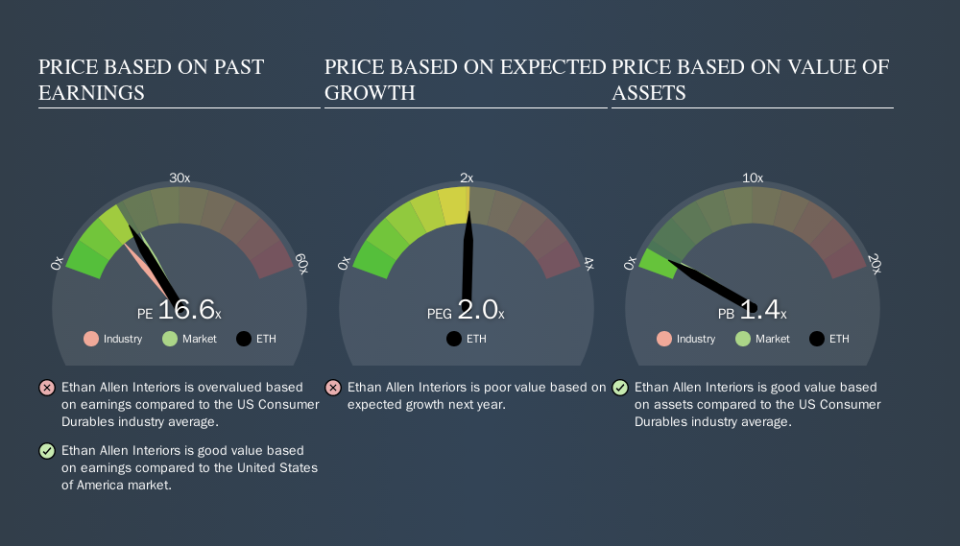Here's What Ethan Allen Interiors Inc.'s (NYSE:ETH) P/E Is Telling Us

The goal of this article is to teach you how to use price to earnings ratios (P/E ratios). We'll look at Ethan Allen Interiors Inc.'s (NYSE:ETH) P/E ratio and reflect on what it tells us about the company's share price. Ethan Allen Interiors has a P/E ratio of 16.56, based on the last twelve months. That means that at current prices, buyers pay $16.56 for every $1 in trailing yearly profits.
Check out our latest analysis for Ethan Allen Interiors
How Do I Calculate A Price To Earnings Ratio?
The formula for price to earnings is:
Price to Earnings Ratio = Price per Share ÷ Earnings per Share (EPS)
Or for Ethan Allen Interiors:
P/E of 16.56 = $19.18 ÷ $1.16 (Based on the year to September 2019.)
Is A High P/E Ratio Good?
A higher P/E ratio means that buyers have to pay a higher price for each $1 the company has earned over the last year. All else being equal, it's better to pay a low price -- but as Warren Buffett said, 'It's far better to buy a wonderful company at a fair price than a fair company at a wonderful price.
How Does Ethan Allen Interiors's P/E Ratio Compare To Its Peers?
We can get an indication of market expectations by looking at the P/E ratio. The image below shows that Ethan Allen Interiors has a higher P/E than the average (12.9) P/E for companies in the consumer durables industry.
Its relatively high P/E ratio indicates that Ethan Allen Interiors shareholders think it will perform better than other companies in its industry classification. The market is optimistic about the future, but that doesn't guarantee future growth. So investors should always consider the P/E ratio alongside other factors, such as whether company directors have been buying shares.
How Growth Rates Impact P/E Ratios
If earnings fall then in the future the 'E' will be lower. That means unless the share price falls, the P/E will increase in a few years. A higher P/E should indicate the stock is expensive relative to others -- and that may encourage shareholders to sell.
Ethan Allen Interiors shrunk earnings per share by 17% over the last year. And over the longer term (5 years) earnings per share have decreased 6.1% annually. This growth rate might warrant a below average P/E ratio.
Remember: P/E Ratios Don't Consider The Balance Sheet
One drawback of using a P/E ratio is that it considers market capitalization, but not the balance sheet. Thus, the metric does not reflect cash or debt held by the company. Theoretically, a business can improve its earnings (and produce a lower P/E in the future) by investing in growth. That means taking on debt (or spending its cash).
Such spending might be good or bad, overall, but the key point here is that you need to look at debt to understand the P/E ratio in context.
How Does Ethan Allen Interiors's Debt Impact Its P/E Ratio?
The extra options and safety that comes with Ethan Allen Interiors's US$46m net cash position means that it deserves a higher P/E than it would if it had a lot of net debt.
The Bottom Line On Ethan Allen Interiors's P/E Ratio
Ethan Allen Interiors trades on a P/E ratio of 16.6, which is below the US market average of 18.2. Falling earnings per share are likely to be keeping potential buyers away, but the net cash position means the company has time to improve: if so, the low P/E could be an opportunity.
When the market is wrong about a stock, it gives savvy investors an opportunity. If it is underestimating a company, investors can make money by buying and holding the shares until the market corrects itself. So this free visualization of the analyst consensus on future earnings could help you make the right decision about whether to buy, sell, or hold.
Of course, you might find a fantastic investment by looking at a few good candidates. So take a peek at this free list of companies with modest (or no) debt, trading on a P/E below 20.
We aim to bring you long-term focused research analysis driven by fundamental data. Note that our analysis may not factor in the latest price-sensitive company announcements or qualitative material.
If you spot an error that warrants correction, please contact the editor at editorial-team@simplywallst.com. This article by Simply Wall St is general in nature. It does not constitute a recommendation to buy or sell any stock, and does not take account of your objectives, or your financial situation. Simply Wall St has no position in the stocks mentioned. Thank you for reading.

